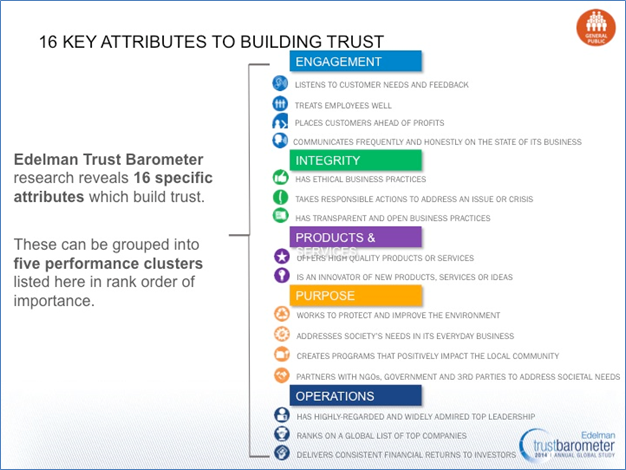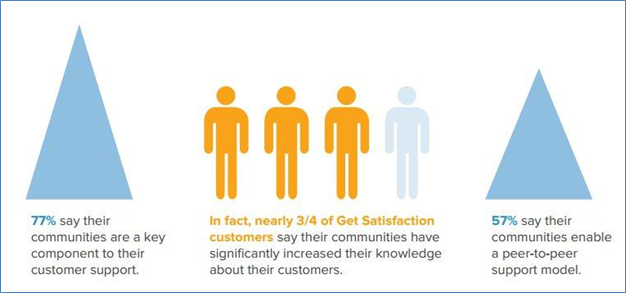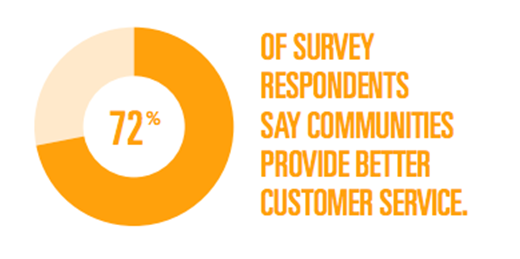Recently, I had the honor of being interviewed by Barry Feldman about online communities and how they can be a powerful trust-building vehicle when they are done well – which ain’t always easy to do. An expert interviewer, Barry is able to pull great ideas out of his victims interviewees to make for an informative and (entertaining) content. I hope you enjoy reading it as much as I enjoyed being interviewed! This article originally appeared on KISSMetrics blog.
___________________________________________________________________
Want to build an online community? When you understand the power of the online community, you’re bound to answer in the affirmative.
Vanessa DiMauro, CEO of Leader Networks, will tell you the online community is the most powerful way to connect with prospects today. Well-run online communities advance trust building.

In a recent webinar, Vanessa DiMauro pointed to numerous spots on the Edelman Trust Barometer and pointed out how online communities can address the issues.
What do you say we check in with Vanessa DiMauro, a top-shelf community builder who’s been at it for about as long as we’ve had online communities?
I’ve read Vanessa’s work for a few years now and when she created “56 Lessons from 20 Years of Online Community Building,” a virtual tablet of commandments for the social age, I had questions. Vanessa agreed to answer them.
First, I wanted to know what’s in the coffee cup she’s clinging to in the photo. She said scotch. I knew the rest of the interview would be fun.
Focus on a vision for your community
High on the list, Vanessa wrote community builders must create a clear, aspirational vision statement and share it with members. She told me the vision statement shapes what the community will ultimately be about and how community members interact.
“It sets the tone for the culture of the community,” she said. “Each community has its own set of normative behaviors that reflects the peer-to-peer and peer-to-company relationship style. As we all know, culture happens whether we design it or not.”
So, writing one’s a cakewalk, right? Guess not…
“Writing a vision statement can be a painful experience, fraught with group-think,” Vanessa said. “The end result tends to be some watered-down, hyperbolic declaration of nothing in particular. This serves no one’s interest.”
She offers a fix for the problem. “I often play a community ‘mad-lib’ game with my clients to help them articulate their intentions and keep the spirit alive. It goes a little something like this:
Members will benefit from __________ and _____________
and will be most excited when they can ____________ online.”

Vanessa cites a survey by Get Satisfaction revealing statistics about what customers want and how brands are approaching their needs.
And then comes an operational plan
Another commandment of Vanessa’s is to create a 90-day operational plan for the community and revise it every each quarter. Why?
“Priorities often change for an organization quarter by quarter, while the overall business strategy generally stays intact. By reviewing the plan every quarter with input from product line leaders, sales, marketing and the merry band, the community can be more responsive to customer and organizational needs.”
She went on to say the plan helps different departments work together. For example, according to Vanessa, if marketing is holding an event, community needs the run time to shepherd members into securing seats. If product development is launching a new product, there needs to be time to tell the members and the early feedback will help support the release.
Creating user generated content
Rule #10: Start with an emphasis on institutional content then plan to shift to organic (user generated) content.
I asked Vanessa to explain how a B2B company could pull it off, that is, generate highly coveted user-generated content. It struck me as a tough trick.
She told me, with online communities, members come for the content and stay for community.
“Each piece of content or interaction needs to be present for a reason. Even user generated content is well served by putting it through a voluntary (user option) editing process to help make the member’s writing be as powerful as possible.”
“It could either be long tail content such as informational articles or how-to guides, or disposable topical content designed to engage in the moment,” she said.
There’s no need to be afraid of “riding meme waves” and tapping into what’s hot in the moment.”
“Successful on-site content is usually SEO-friendly guides written by the community, or articles written by the community manager focusing on community interests or topics in need of new community participants.”
She explained some communities will focus on lifestyle discussions or topics not directly related to a brand’s products, but for which the brand stands to benefit from the exposure.
B2B and B2C communities differ
In rule #23 of her list post, Vanessa wrote you need to understand B2B and B2C communities have very different best practices.
“B2B online communities are professional networks that contain a blend of content and collaboration opportunities around a shared business-based experience. They are commonly established between a business and customers, professional associations or like-minded professionals.”
Vanessa said many examples of B2B communities are not visible to the general public. They serve a specific audience with a “gated experience” for their members. B2B communities tend to be smaller than their B2C counterparts, anywhere from a hundred members upward.
On the B2C side, communities can be very large and tend to focus on a specific activity related to the use of a brand’s products.
“B2C online communities are brand-to-consumer and consumer-to-consumer focused networks. They provide a platform for engagement with the brand, or support customers using the brand’s products.”
According to Vanessa, the vast majority of online communities fall under this banner, whether the online community is a Twitter account for interacting with customers or a customer service forum to support discussion around the use of products.

Source: “Get it Together: Why You Need an Online Community” by GetSatisfaction.com.
Finding an inner circle
I learned from Vanessa every successful online community relies on a solid core group that keeps it growing. I asked Vanessa how you go about finding and developing the ever-important “inner circle” or core.
Her answer: “Form a beta group, baby.”
She suggested the beta group could be made up of the first 50 – 250 members who are friends of the firm, clients, or partners who have an interest in being “community pioneers.”
“Be sure they are formally invited to participate in the beta program with a defined start and a clear value proposition (for them),” she said.
She pointed out that, pre-launch, it’s important to get the beta group to model the behavior the rest of the community will follow when the group officially goes live.
“They fill out their profile, participate in a few discussions with each other, submit content, sit for an interview or three and fill the community with activity, so others know what to do and how to interact online. This goes a very long way with senior level communities, but is important to them all.”
About the author: Barry Feldman operates Feldman Creative and is known for providing clients content marketing strategies that rock and creative that rolls. And, he is quite the king himself, named a Top 40 Digital Strategist by Online Marketing Institute and one of 25 Social Media Marketing Experts You Need to Know by LinkedIn. His blog is The Point.
1/15/15
Warning: Attempt to read property "base" on array in /home3/trusten9/public_html/leadernetworks/wp-content/plugins/wp-user-profile-avatar/shortcodes/wp-user-profile-avatar-shortcodes.php on line 665
Warning: Attempt to read property "base" on array in /home3/trusten9/public_html/leadernetworks/wp-content/plugins/wp-user-profile-avatar/shortcodes/wp-user-profile-avatar-shortcodes.php on line 665
Warning: Attempt to read property "base" on array in /home3/trusten9/public_html/leadernetworks/wp-content/plugins/wp-user-profile-avatar/shortcodes/wp-user-profile-avatar-shortcodes.php on line 665
Warning: Attempt to read property "base" on array in /home3/trusten9/public_html/leadernetworks/wp-content/plugins/wp-user-profile-avatar/shortcodes/wp-user-profile-avatar-shortcodes.php on line 665
Vanessa DiMauro
Internationally recognized independent thought leader on social business strategy and operations with a specialty in online community. I help organizations drive top line growth through innovative digital strategy design and thoughtful execution. I have successfully led 60+ strategic social business initiatives for the world's most influential organizations over my 20 years as a social business executive and serve on a number of boards. My award-winning track-record is fueled by passion, experience and research.
My work has been covered by leading publications such as the New York Times, the Wall Street Journal and CIO Magazine and was recently named a Social Marketing Master by Forbes. As a former Executive in Residence at Babson College, Olin School of Management, I am an engaging and informational educator and keynote speaker.
Related Posts
January 27, 2017
What does customer intimacy really look like?
Our events were unique because they delivered something our customers couldn’t…
4 Comments
Add comment Cancel reply
This site uses Akismet to reduce spam. Learn how your comment data is processed.




Cupshe Guest Of Honor
[…] ample, according to Vanessa, if marketing is holding an event, community needs t […]
nice post
yo tengo mi web en internet y esto me ayudo a tener una buena perpectiva de lo que es el ciber en cuestion de noticias, mi web armex.mx saludos
This brings the online community to a simple term, I so much love this. Will sure come back. thanks.